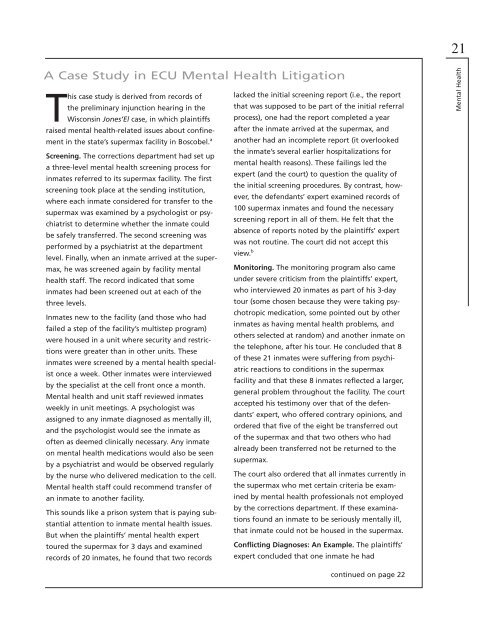Supermax Prisons and the Constitution: Liability ... - Supermaxed
Supermax Prisons and the Constitution: Liability ... - Supermaxed
Supermax Prisons and the Constitution: Liability ... - Supermaxed
Create successful ePaper yourself
Turn your PDF publications into a flip-book with our unique Google optimized e-Paper software.
21A Case Study in ECU Mental Health LitigationThis case study is derived from records of lacked <strong>the</strong> initial screening report (i.e., <strong>the</strong> report<strong>the</strong> preliminary injunction hearing in <strong>the</strong> that was supposed to be part of <strong>the</strong> initial referralWisconsin Jones’El case, in which plaintiffs process), one had <strong>the</strong> report completed a yearraised mental health-related issues about confinementin <strong>the</strong> state’s supermax facility in Boscobel. a ano<strong>the</strong>r had an incomplete report (it overlookedafter <strong>the</strong> inmate arrived at <strong>the</strong> supermax, <strong>and</strong><strong>the</strong> inmate’s several earlier hospitalizations forScreening. The corrections department had set upmental health reasons). These failings led <strong>the</strong>a three-level mental health screening process forexpert (<strong>and</strong> <strong>the</strong> court) to question <strong>the</strong> quality ofinmates referred to its supermax facility. The first<strong>the</strong> initial screening procedures. By contrast, however,<strong>the</strong> defendants’ expert examined records ofscreening took place at <strong>the</strong> sending institution,where each inmate considered for transfer to <strong>the</strong>100 supermax inmates <strong>and</strong> found <strong>the</strong> necessarysupermax was examined by a psychologist or psychiatristto determine whe<strong>the</strong>r <strong>the</strong> inmate couldscreening report in all of <strong>the</strong>m. He felt that <strong>the</strong>absence of reports noted by <strong>the</strong> plaintiffs’ expertbe safely transferred. The second screening waswas not routine. The court did not accept thisperformed by a psychiatrist at <strong>the</strong> departmentview. blevel. Finally, when an inmate arrived at <strong>the</strong> supermax,he was screened again by facility mental Monitoring. The monitoring program also camehealth staff. The record indicated that someunder severe criticism from <strong>the</strong> plaintiffs’ expert,inmates had been screened out at each of <strong>the</strong> who interviewed 20 inmates as part of his 3-daythree levels.tour (some chosen because <strong>the</strong>y were taking psychotropicmedication, some pointed out by o<strong>the</strong>rInmates new to <strong>the</strong> facility (<strong>and</strong> those who hadinmates as having mental health problems, <strong>and</strong>failed a step of <strong>the</strong> facility’s multistep program)o<strong>the</strong>rs selected at r<strong>and</strong>om) <strong>and</strong> ano<strong>the</strong>r inmate onwere housed in a unit where security <strong>and</strong> restrictionswere greater than in o<strong>the</strong>r units. These<strong>the</strong> telephone, after his tour. He concluded that 8of <strong>the</strong>se 21 inmates were suffering from psychiatricreactions to conditions in <strong>the</strong> supermaxinmates were screened by a mental health specialistonce a week. O<strong>the</strong>r inmates were interviewedfacility <strong>and</strong> that <strong>the</strong>se 8 inmates reflected a larger,by <strong>the</strong> specialist at <strong>the</strong> cell front once a month.general problem throughout <strong>the</strong> facility. The courtMental health <strong>and</strong> unit staff reviewed inmatesaccepted his testimony over that of <strong>the</strong> defendants’expert, who offered contrary opinions, <strong>and</strong>weekly in unit meetings. A psychologist wasassigned to any inmate diagnosed as mentally ill,ordered that five of <strong>the</strong> eight be transferred out<strong>and</strong> <strong>the</strong> psychologist would see <strong>the</strong> inmate asof <strong>the</strong> supermax <strong>and</strong> that two o<strong>the</strong>rs who hadoften as deemed clinically necessary. Any inmatealready been transferred not be returned to <strong>the</strong>on mental health medications would also be seensupermax.by a psychiatrist <strong>and</strong> would be observed regularlyby <strong>the</strong> nurse who delivered medication to <strong>the</strong> cell. The court also ordered that all inmates currently inMental health staff could recommend transfer of <strong>the</strong> supermax who met certain criteria be examinedby mental health professionals not employedan inmate to ano<strong>the</strong>r facility.by <strong>the</strong> corrections department. If <strong>the</strong>se examinationsfound an inmate to be seriously mentally ill,This sounds like a prison system that is paying substantialattention to inmate mental health issues.that inmate could not be housed in <strong>the</strong> supermax.But when <strong>the</strong> plaintiffs’ mental health experttoured <strong>the</strong> supermax for 3 days <strong>and</strong> examined Conflicting Diagnoses: An Example. The plaintiffs’records of 20 inmates, he found that two records expert concluded that one inmate he hadMental Healthcontinued on page 22


